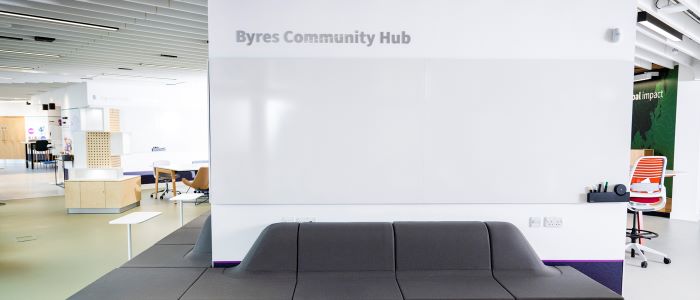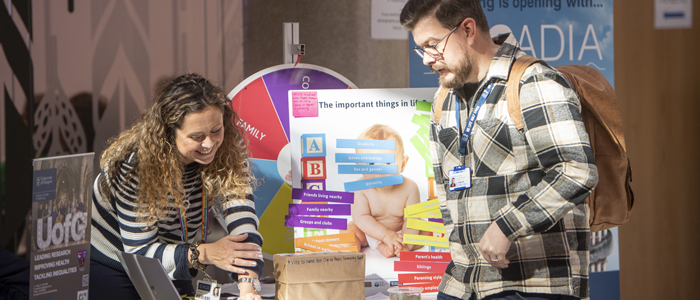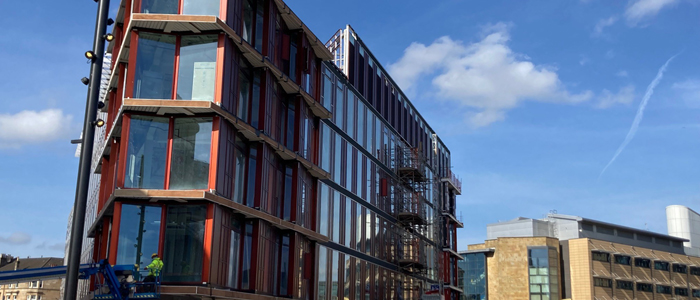Can the Clarice Pears support School of Health and Wellbeing’s commitment to equality and diversity?
Published: 15 September 2022
SHW's community engagement officer Susan Grant shares her reflections on the ways in which our new building may contribute to inclusiveness and wellbeing
SHW's community engagement officer Susan Grant shares her reflections on the ways in which our new building may contribute to inclusiveness and wellbeing.
"First life, then spaces, then buildings. The other way around never works"
This quote on the design of urban spaces by Danish architect, Jan Gehl was first shared to me by a colleague at Glasgow Caledonian University years ago and it has stuck with me ever since. The campus development at University of Glasgow has very much been designed as Gehl would advocate with the pedestrian and cyclist in mind and the natural environment with new avenues from Byres Road to Kelvingrove Park, St Mungo’s square; a multipurpose outdoor space with rain gardens to release water slowly into the river Kelvin.
Our Clarice Pears building too with its bright space, natural ventilation, indoor plants and living wall to "bring the outside inside" has been designed with the users' wellbeing in mind. But more than that it has social spaces on the upper floors and an accessible and inclusive space on the ground floor open to the public to foster collaboration. Clarice Pears will "broaden public access to and use of our campus locations and assets" (UofG Strategy 2025) and through a commitment to community engagement with the development of the Clarice Pears hub, our staff and students will make connections with people and groups traditionally underrepresented in education and research to bring more diverse and representative voices of lived experience into our research and teaching. Therefore, I believe that this building can support our commitment to Athena Swan and equality and diversity.
When I have asked staff what their hopes are in moving to Clarice Pears, the most common responses have centered on the opportunities it will afford for collaboration with one another, but they also are optimistic for it to be:
- "Something a bit different – to be innovative and go beyond what we usually do"
- "For stronger networking opportunities. I have hopes that with a new geography comes new connections and the small social conversations from which big ideas emerge"
- "A space the local and wider community feel is accessible and welcoming, and that it will fulfil the needs THEY identify"
- "A beautiful, inviting space, that supports all types of engagement, including transitory, and is a welcoming space from the rain!"
- "Successful as a building for everyone who might use it and that it becomes more than a building!"
The Clarice Pears can only achieve all of this by firstly building relationships (life) and engaging where our communities are (spaces). It is this engagement that is at the centre of the Clarice Pears public engagement workstream, led by Prof Sara Macdonald and the many researchers and students who have coproduce research. Great examples include The MRC/CSO Social and Public Health Science Unit’s Equally Safe at School and the recent "This is Me" campaign from the Scottish Learning Disability Observatory. This is also what our consultation on the Clarice Pears public space and community "hub" has been all about.

Naming the Clarice Pears Community Space
As part of this consultation, we invited suggestions for names for the space and hub. Our school and community online and at various in person events have recently been voting on a short-list of six. Thanks to everyone who voted. The two most popular options were The Community Byre and The Community Engagement Hub.
The latter was more popular with our internal voters and it "does what it says on the tin" but it is not as catchy as the former. The Community Byre was more popular with our external voters: it gives a sense of place in terms of the link with the address of the building on Byres Road and is an ode to the history of the area. In the Middle Ages, the Bishops of Glasgow travelled through "the Byres of Patrick" to reach Partick Castle and of course the University relocating from the city’s High Street to Gilmorehill in 1870 when most of the area was open farmland and a resting spot for Highland drovers bringing their cattle to market in Glasgow. [Source: History of Byres Road – visitwestend.com]
After discussions at the SHW management group and community engagement group we propose a name which encompasses both options – Byres Community Hub.

Campus development update: Clarice Pears building nears completion
First published: 15 September 2022


